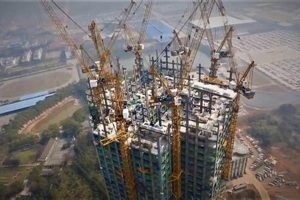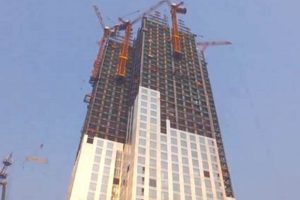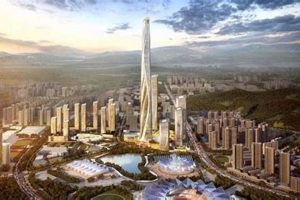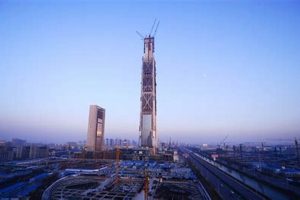A mile-high skyscraper is a hypothetical supertall skyscraper that would be over 1,600 meters (5,200 feet) tall. No such building currently exists, but several proposals have been made over the years. The tallest building in the world, the Burj Khalifa, is just over 828 meters (2,717 feet) tall.
Mile-high skyscrapers would pose a number of engineering and construction challenges, including:
- The need for a very strong foundation to support the immense weight of the building.
- Finding materials that are strong enough to withstand the high winds and earthquakes that could occur at such a height.
- Developing elevators and other means of transportation that can quickly and efficiently move people and goods up and down the building.
Despite these challenges, mile-high skyscrapers would offer a number of potential benefits, including:
- Increased office and residential space in densely populated urban areas.
- Improved views and natural light for occupants.
- Reduced traffic congestion by providing a central location for businesses and residents.
Whether or not mile-high skyscrapers will ever become a reality remains to be seen. However, the engineering and architectural challenges involved in building such a structure are certainly intriguing.
Main article topics:
- Engineering challenges of mile-high skyscrapers
- Construction methods for mile-high skyscrapers
- Potential benefits of mile-high skyscrapers
- History of mile-high skyscraper proposals
1. Engineering challenges
Mile-high skyscrapers pose a number of unique engineering challenges, including:
- Structural stability: A mile-high skyscraper would be extremely tall and slender, making it susceptible to wind and seismic forces. Engineers would need to design a structure that is strong enough to withstand these forces without collapsing.
- Wind resistance: The wind speeds at the top of a mile-high skyscraper would be much higher than at ground level. Engineers would need to design a building that can withstand these high wind speeds without swaying excessively.
- Seismic resistance: Earthquakes can cause buildings to sway and collapse. Engineers would need to design a mile-high skyscraper that can withstand the forces of an earthquake without collapsing.
- Fire safety: A fire in a mile-high skyscraper would be difficult to extinguish. Engineers would need to design a building that includes fire safety features such as sprinklers, smoke detectors, and fire escapes.
These are just some of the engineering challenges that would need to be overcome in order to build a mile-high skyscraper. However, with advances in materials science and engineering techniques, it may be possible to build such a structure in the future.
2. Construction methods
The construction methods used for mile-high skyscrapers would need to be innovative and groundbreaking, as no existing methods are capable of building such a tall structure. Some of the new construction methods that could be used include:
- Modular construction: This involves building the skyscraper in sections on the ground and then assembling them on site. This method would reduce the amount of time and labor required to build the skyscraper, and it would also make it easier to make changes to the design during construction.
- Vertical transportation: Moving people and materials up and down a mile-high skyscraper would be a major challenge. New methods of vertical transportation would need to be developed, such as high-speed elevators or even maglev trains.
- Sustainable construction: Mile-high skyscrapers would need to be built in a sustainable way, using materials and methods that minimize their environmental impact. This could include using recycled materials, renewable energy sources, and efficient water and energy systems.
- Advanced materials: New materials would need to be developed to build mile-high skyscrapers. These materials would need to be strong, lightweight, and fire-resistant. They would also need to be able to withstand the high winds and seismic forces that could occur at such a height.
These are just some of the new construction methods that could be used to build mile-high skyscrapers. With advances in materials science and engineering techniques, it may be possible to build such a structure in the future.
3. Potential benefits
Mile-high skyscrapers have the potential to offer a number of benefits, including increased office and residential space in densely populated urban areas, improved views and natural light for occupants, and reduced traffic congestion by providing a central location for businesses and residents.
- Increased office and residential space: Mile-high skyscrapers could provide much-needed office and residential space in densely populated urban areas. This could help to alleviate the housing crisis in many cities and reduce the cost of living.
- Improved views and natural light: Occupants of mile-high skyscrapers would enjoy improved views and natural light. This could lead to a number of benefits, such as increased productivity, reduced stress, and improved sleep quality.
- Reduced traffic congestion: Mile-high skyscrapers could reduce traffic congestion by providing a central location for businesses and residents. This would allow people to live and work in the same building, reducing the need for commuting.
Overall, mile-high skyscrapers have the potential to offer a number of significant benefits. However, it is important to weigh these benefits against the challenges involved in building and maintaining such structures.
4. History of proposals
The history of mile-high skyscraper proposals dates back to the early 20th century. In 1919, American architect William Van Alen proposed a 1,250-foot (381-meter) skyscraper for New York City. This proposal was never realized, but it sparked a wave of interest in mile-high skyscrapers. In the 1930s, several other proposals were made for mile-high skyscrapers in New York City and Chicago, but none of these proposals were ever built.
In the 1950s and 1960s, interest
in mile-high skyscrapers waned. However, in the 1970s, interest in these structures was revived. In 1975, architect Fazlur Rahman Khan proposed a 1,454-foot (443-meter) skyscraper for Chicago. This proposal was never built, but it inspired other architects to design mile-high skyscrapers. In the 1980s and 1990s, several other proposals were made for mile-high skyscrapers in various cities around the world, but none of these proposals were ever built.
In the early 21st century, interest in mile-high skyscrapers has continued to grow. In 2010, architect Adrian Smith proposed a 1,700-foot (518-meter) skyscraper for Dubai. This proposal is still in the planning stages, but it is one of the most ambitious mile-high skyscraper proposals to date.
The history of mile-high skyscraper proposals is a long and fascinating one. These structures have captured the imagination of architects and engineers for over a century. While no mile-high skyscraper has ever been built, the history of these proposals provides valuable insights into the engineering challenges and the potential benefits of these structures.
5. Economic impact
The construction and operation of a mile-high skyscraper would have a significant economic impact on the surrounding area. The project would create thousands of jobs and boost the local economy. Once completed, the skyscraper would be a major tourist attraction and a hub for businesses and commerce.
- Job creation: The construction of a mile-high skyscraper would create thousands of jobs in a variety of fields, including architecture, engineering, construction, and real estate. These jobs would provide a much-needed boost to the local economy and help to create a more vibrant and prosperous community.
- Increased tax revenue: The construction and operation of a mile-high skyscraper would generate significant tax revenue for the local government. This revenue could be used to fund important public services, such as education, healthcare, and infrastructure.
- Increased tourism: A mile-high skyscraper would be a major tourist attraction, drawing visitors from all over the world. This influx of tourists would boost the local economy by creating jobs in the hospitality and tourism industries.
- Hub for businesses and commerce: A mile-high skyscraper would be a central location for businesses and commerce. This would make it easier for businesses to connect with customers and partners, and it would also create a more efficient and dynamic business environment.
Overall, the construction and operation of a mile-high skyscraper would have a significant positive economic impact on the surrounding area. The project would create thousands of jobs, boost the local economy, and create a more vibrant and prosperous community.
6. Environmental impact
The construction and operation of a mile-high skyscraper would have a significant environmental impact. The project would require a vast amount of resources, including energy, water, and materials. The construction process would also generate pollution and greenhouse gases. Once completed, the skyscraper would be a major consumer of energy and water.
- Energy consumption: A mile-high skyscraper would require a vast amount of energy to operate. This energy would be used to power the building’s systems, including heating, cooling, lighting, and elevators. The skyscraper would also consume energy for its tenants’ activities, such as office work and residential living.
- Water consumption: A mile-high skyscraper would also require a vast amount of water. This water would be used for drinking, sanitation, and irrigation. The skyscraper would also use water for its cooling systems and other building operations.
- Pollution: The construction and operation of a mile-high skyscraper would generate pollution. This pollution would include air pollution from construction equipment and traffic, and water pollution from stormwater runoff. The skyscraper would also generate greenhouse gases, which contribute to climate change.
- Resource depletion: The construction of a mile-high skyscraper would require a vast amount of resources, including steel, concrete, and glass. These resources are finite, and their extraction and processing can have a negative impact on the environment.
The environmental impact of a mile-high skyscraper would be significant. It is important to carefully consider these impacts before proceeding with the construction of such a structure.
7. Social impact
The construction and operation of a mile-high skyscraper would have a significant social impact on the surrounding community. The project would create thousands of jobs, boost the local economy, and create a new landmark for the city. However, it is important to consider the potential negative social impacts of such a large-scale project.
One potential negative social impact of a mile-high skyscraper is the displacement of low-income residents. The construction of such a large-scale project would likely lead to increased land values in the surrounding area, which could force low-income residents out of their homes. It is important to consider the social impact of such a project and to take steps to mitigate the negative impacts on low-income residents.
Another potential negative social impact of a mile-high skyscraper is the creation of a new class divide. The building would likely be very expensive to live or work in, and this could create a new class divide between those who can afford to live in the building and those who cannot. It is important to consider the social impact of such a project and to take steps to ensure that the building does not create a new class divide.
Overall, the construction and operation of a mile-high skyscraper would have a significant social impact on the surrounding community. It is important to consider both the positive and negative social impacts of such a large-scale project and to take steps to mitigate the negative impacts.
FAQs on Mile-High Skyscrapers
Mile-high skyscrapers are hypothetical supertall skyscrapers that would be over 1,600 meters (5,200 feet) tall. No such building currently exists, but several proposals have been made over the years.
Question 1: Are mile-high skyscrapers possible to build?
Answer: With advances in materials science and engineering techniques, it may be possible to build a mile-high skyscraper in the future. However, there are a number of engineering challenges that would need to be overcome, such as structural stability, wind resistance, and seismic resistance.
Question 2: What are the potential benefits of building a mile-high skyscraper?
Answer: Mile-high skyscrapers could provide much-needed office and residential space in densely populated urban areas, improved views and natural light for occupants, and reduced traffic congestion by providing a central location for businesses and residents.
Question 3: Wh
at are the challenges of building a mile-high skyscraper?
Answer: There are a number of engineering challenges that would need to be overcome in order to build a mile-high skyscraper, such as structural stability, wind resistance, seismic resistance, fire safety, and vertical transportation.
Question 4: What are the potential environmental impacts of building a mile-high skyscraper?
Answer: The construction and operation of a mile-high skyscraper would have a significant environmental impact. The project would require a vast amount of resources, including energy, water, and materials. The construction process would also generate pollution and greenhouse gases.
Question 5: What are the potential social impacts of building a mile-high skyscraper?
Answer: Construction and operation of a mile-high skyscraper would have a significant social impact. The project would create thousands of jobs, boost the local economy, and create a new landmark for the city. However, it is important to consider both the positive and negative social impacts and to take steps to avoid negative impacts.
Question 6: What is the future of mile-high skyscrapers?
Answer: It is difficult to say whether or not mile-high skyscrapers will ever become a reality. However, with advances in materials science and engineering techniques, it is possible that such a structure could be built in the future.
Summary: Mile-high skyscrapers are an ambitious and challenging concept, but with advances in technology, they may one day become a reality. It is important to carefully consider the engineering, environmental, and social impacts of these structures before proceeding with construction.
Transition: The next section will explore the history of mile-high skyscraper proposals in more detail.
Tips on Mile-High Skyscrapers
Mile-high skyscrapers are a fascinating concept, but they also pose a number of engineering challenges. Here are a few tips to keep in mind if you’re considering building a mile-high skyscraper:
Tip 1: Start with a strong foundation. The foundation of a mile-high skyscraper must be strong enough to support the immense weight of the building. This means using deep foundations that extend far into the ground.
Tip 2: Use lightweight materials. The materials used to build a mile-high skyscraper must be lightweight and strong. This will help to reduce the overall weight of the building and make it more resistant to wind and seismic forces.
Tip 3: Design for wind resistance. Mile-high skyscrapers will be exposed to high winds, so it is important to design the building to be wind-resistant. This can be done by using aerodynamic shapes and incorporating wind-resistant features into the design.
Tip 4: Design for seismic resistance. Mile-high skyscrapers must also be able to withstand earthquakes. This can be done by using base isolation systems or other seismic-resistant design features.
Tip 5: Use sustainable materials and construction methods. Mile-high skyscrapers should be built using sustainable materials and construction methods. This will help to reduce the environmental impact of the building.
Summary: Building a mile-high skyscraper is a complex and challenging undertaking, but it is possible with careful planning and engineering. By following these tips, you can increase the chances of success.
Transition: The next section will explore the history of mile-high skyscraper proposals in more detail.
Conclusion
Mile-high skyscrapers are an ambitious and challenging concept, but they also offer the potential for significant benefits. These structures could provide much-needed office and residential space in densely populated urban areas, improved views and natural light for occupants, and reduced traffic congestion by providing a central location for businesses and residents.
However, there are also a number of engineering, environmental, and social challenges that would need to be overcome in order to build a mile-high skyscraper. It is important to carefully consider these challenges and to develop innovative solutions before proceeding with construction.
Despite the challenges, the concept of a mile-high skyscraper is a fascinating one. These structures have the potential to reshape our cities and the way we live in them. With advances in materials science and engineering techniques, it is possible that mile-high skyscrapers could become a reality in the future.







